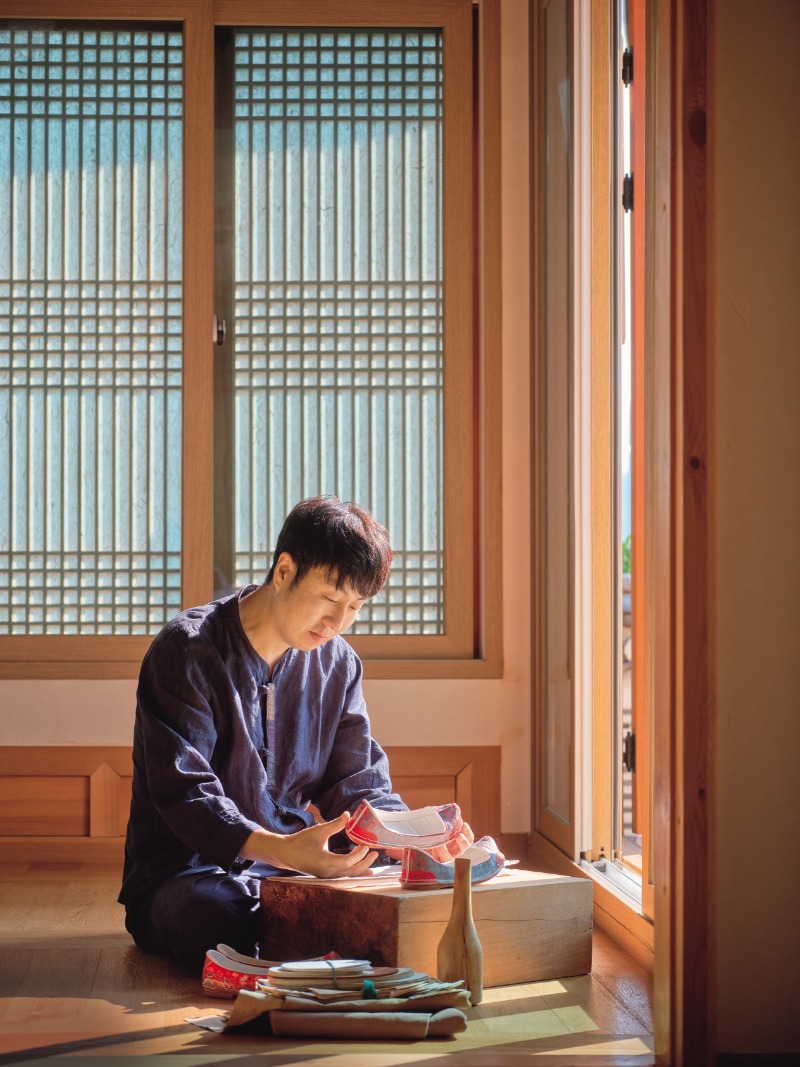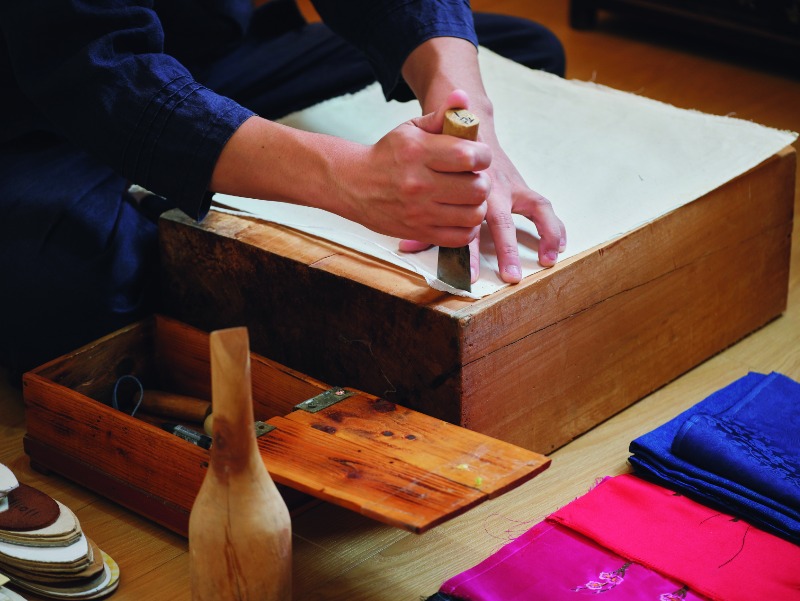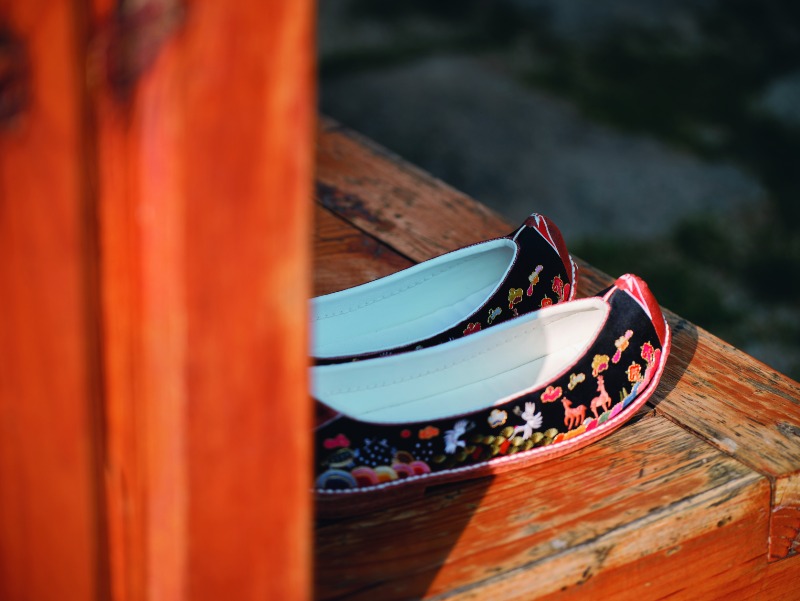Crafting traditional Korean shoes involves over seventy meticulous procedures and requires the utmost precision and skill. With styles and names varying depending on the owner’s social status, gender, and age, traditional shoes are the same left and right but gradually conform to the shape of each foot. Following in his father’s footsteps, Hwang Duck-sung carries on the family business that has continued for six generations.

Born into a family of traditional shoemakers for six generations, Hwang Duck-sung continues the legacy following the footsteps of his father, who is a master artisan in traditional shoemaking.
Traditional Korean shoes are characterized by elegant curves. The sides of the shoes converge at the slightly upturned toes, as beautiful as the curved eaves of a tile-roof hanok (traditional Korean house). Notably, Korean shoes are identical for both feet. Over time and use, they conform to the shape of each foot for the comfort of the wearer, naturally evolving into the left shoe and right shoe.
Traditional Korean footwear is called hwahye, a compound of hwa, referring to high shoes that cover the ankles (or shins), and hye, referring to low-cut shoes that do not cover the ankles. Shoemakers were called hwahyejang or gatbachi (leatherworkers), and have often been featured in period films or dramas set in the Joseon Dynasty (1392-1910). According to the “National Code” (Gyeongguk daejeon), a compendium of the basic statutes of Joseon, several dozen shoemakers were employed by the central government alone, indicating robust demand for shoes at the time and a production process based on division of labor and specialization.
Yu Hui-chun (1513-1577), a civil official of the mid-Joseon era, writes in “Miam’s Diary” (Miam ilgi) that the materials, shapes, and colors of the shoes varied not only by the occasion, including major ceremonies of life, but by the owner’s social status. Age also determined the colors used and the way they were arranged on the shoes. The materials were diverse and included hemp, ramie, paper, wood, and straw, as well as leather. Today, traditional shoes are still worn on special occasions, such as weddings and ancestral rites, to enhance the ceremonial atmosphere.
Not By Choice, But Destiny
“When I was young, my family was so financially unstable that my father had a side job as a courier. It was hard for him to make ends meet just by making traditional shoes, as there was little demand for them. Wanting to avoid the economic hardship associated with the craft, I worked briefly in an office after graduating from college. Just when I realized that I wasn’t suited to the job, my father finally succeeded in a restoration project that he had worked on for a long time. I had watched him throughout the process, and I realized how meaningful it was to save a craft from the brink of extinction. It was a critical moment that made me accept my destiny to work in the family business,” Hwang says.
Hwang’s life as a traditional craftsman may have been fated from birth. Based in Insa-dong, Seoul, where a community of court artisans had formed in the Joseon era, his family produced generations of master shoemakers. After the craft of making the two types of traditional shoes was included separately (as hwajang and hyejang) on the list of National Intangible Cultural Heritage, his great-grandfather, Hwang Han-gap, was designated by the state as the first master artisan in the category of hwajang in 1971. His father, Hwang Hae-bong, also became a master artisan in 2004 after the two shoemaking categories were merged and called hwahyejang. Higher in his family tree is the very person who started the family business, his great-great-great-grandfather, Hwang Jong-su, who supplied leather shoes to the court during the reign of King Cheoljong (r. 1849-1863). And now the legacy is continued by Hwang Duck-sung, the family’s sixth-generation shoemaker, who was designated in 2016 as a certified trainee in the art of shoemaking.
“It was my great-grandfather’s grandfather who started to make shoes for the court of Joseon, and my great-grandfather made shoes for Joseon’s last royal family. He is known to have made a pair of red shoes for Emperor Gojong’s ceremonial attire. Sadly, the actual shoes were lost, leaving us with only the documents stating the fact. He died in 1982, when my father was thirty and I was three. At the time, my grandfather had been dead for two years and transmission of the craft in my family was threatened. Fortunately, the situation was reversed later when my father successfully recreated a pair of royal ceremonial shoes [seok],” Hwang says.
In a box that Hwang takes down from the top shelf of a display case are two pairs of the recreated royal shoes. The red ones (jeokseok) were worn by kings and crown princes, and the blue ones (cheongseok) by queens and crown princesses as a part of their ritual attire. Once these shoes were almost forgotten, except as objects in historical texts, but Hwang’s father managed to restore them based on scholarly consultation and research.

As the first step of making traditional shoes, Hwang cuts out the patterns of the insides (baekbi) from a sheet of strong cotton cloth. Traditional Korean shoes are crafted through over 70 procedures carried out by a proficient artisan.
Taking the Shape of the Wearer’s Feet
It takes four to ten days to make a pair of hye, the low-cut shoes nicknamed “flower shoes” for their embroidered floral decoration. In the hands of a skilled artisan, they go through seventy procedures before they are completed.
The first step of making any kind of traditional shoes is to prepare the insides ( baekbi) of the two side pieces composing the upper ( sinul). They are made with strong cotton cloth and multiple layers of hemp and ramie, all stuck together with rice paste, and then dried for several days in an airy place. A piece of silk is cut in the same shape, then pasted onto the outside. While these sides are being made, they are repeatedly placed in an earthenware jar containing a wet towel to prevent the rice paste from hardening. Each step requires great skill and the patience to wait until the materials reach the optimal state for handling.
The next step is to join the two sides of the upper using a boar bristle as a needle and thick cotton thread coated with beeswax. The pieces are first sewn together at the heel, and then at the toe. The sole, made with cowhide, is sewn onto the upper, and finally a wooden last is inserted inside the shoe to shape it.
“In the traditional way, we use a boar bristle so as not to damage the silk fabric. Both stiff and pliable, the bristle of an aged boar makes a good needle to use when working with leather and silk. The paste is made of mashed cooked rice, which is applied by hand. It becomes rock-hard as it dries, keeping the shape of the shoes intact,” Hwang says.
When asked which element of traditional shoes makes them so special, the artisan points to the toe, turning up in a graceful curve. The upturned toe is not only striking but also functional as it prevents the shoe from slipping off the foot.
“The shoes are made with no distinction between the left and right feet, but they become distinguishable after a period of use. Traditional Korean shoes are unique in that they gradually conform to the shape of the wearer’s feet. The feet are not forced to get used to the shoes,” Hwang says.

A pair of women’s shoes embroidered with ten symbols of longevity are laid neatly on the narrow wooden verandah. Traditional shoes are classified into various types, depending on the shape, materials, and usage. One type is suhye, embroidered silk shoes commonly called “flower shoes,” which were usually worn by upper-class women.
A Calling to Preserve Tradition
There was a time when Hwang was interested in modifying traditional shoes to increase general demand. But he was bothered by the way people would mistake mass-produced “flower shoes” for an authentic representation of tradition.
“As in modernized hanbok, it is meaningful to modify tradition to adapt to the daily lives, tastes, and needs of people today. It is true that I was stimulated by such attempts, but in the end, someone should try to preserve the traditional ways,” Hwang says. “My father set me a good example by recreating the relics of our ancestors, and I think it is my calling to keep the tradition alive for posterity.”
An exhibition held in July 2022 at the Korea Craft & Design Foundation (KCDF) in Insa-dong, Seoul, showcasing works by master artisans whose skills are designated as National Intangible Cultural Heritage, gave the young craftsman a fresh perspective. Finally opened after a three-year delay due to the COVID-19 pandemic, the exhibition planned to offer one-day classes on a reservation basis. The classes proved so popular that they were continued even after the end of the exhibition.
Hwang was delighted to find that most of the participants were young people. “They were surprised by the exquisite beauty of our traditional shoes and pleased to have the opportunity to personally make them,” he recalls. The experience made him realize that raising awareness of tradition through lectures and demonstrations is as important as modernization. As inquiries for classes continue to come in, he plans to offer them regularly.
“I’m also looking for a way to simplify the manufacturing process in terms of materials and techniques without omitting major procedures. We have no trainees to work with, and it’s hard for my father and me to take on the task alone. But my wife helps and supports me a lot, just as my mother helped my father her whole life. And my two sons, although still young, make me feel reassured.”
The path laid before artisans of endangered traditional crafts is bound to be lonely. Certainly, the case is no different for Hwang Duck-sung, but somehow he has an air of quiet confidence.
Lee Gi-sook Freelance Writer
Lee Min-hee , Photographer